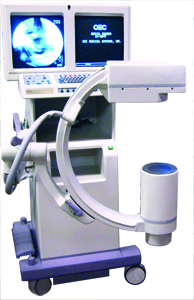
Beyond the obvious size contrast, there are several key differences between mini-C-arm, full size C-arm, and compact C-arm systems.
Just like Goldilocks' three bears and their beds, chairs, and porridge, there is a C-arm that's just right for everyone. When you’re evaluating C-arm options, there are several questions you should be asking, including:
- What procedures will the C-arm be used for?
- What is your budget for equipment and maintenance?
- How much space is available for the C-arm?
- What imaging capabilities does your facility require?
Below we'll share the differences and advantages of each C-arm type, pricing resources, and pros and cons of each system. (We've also listed out some of the most popular C-arm machine options from top manufacturers for each category).
Mini C-Arm
A mini-C-arm is designed to scan patient extremities. This C-arm has a much smaller arc and lower generator power capacity, making it suitable for hands, feet, wrists, and elbows. A few models are even capable of some limited shoulder scans.
Here are a few systems that are popular in the current mini-C-arm market.

Systems
- OEC - 6600, 6800
- Fluoroscan - Insight II, Insight Flex
- Orthoscan - HD1000, FD
Features
Mini C-arms typically feature a smaller detector size and lower power output compared to their full-size counterparts. In comparison to a full or compact C-arm the system has a monitor cart with a small C-arm attached.
The smaller image intensifier also means less radiation. A study found that mini C-arms release 120-400 mrem/min. In contrast, full-sized C-arms emit 200 to 4000 mrem/min of radiation.
Because of their size, mini-C-arms cannot scan larger areas. Typically, anything larger than a shoulder or knee would require a compact or full-size C-arm.
However, they excel in terms of mobility and ease of use. Many mini-C-arms offer fluoroscopy and digital radiography capabilities, allowing for both dynamic and static imaging during procedures.
Pros:
- Lightweight and easy to maneuver in a workplace.
- Lower initial cost compared to full-size models.
- Surgeon-operated, doesn’t require a radiographer.
- Reduced radiation exposure.
Cons:
- Limited Field of View and lower imaging quality.
- Typically, only used for extremity surgeries.
- Cannot penetrate dense anatomy.
Best For: Facilities specializing in extremity work, minor surgical procedures, or that have limited space availability can benefit the most from purchasing a mini C-arm.
Full Size C-Arm
Full-size C-arms are designed with a large “C” shaped mobile unit and a monitor cart. They have the largest arc to fit patients and surgical tables inside, the highest generator output to scan through the thickest parts of the body, and the most software options to fit the needs of any specialty.

Systems
- OEC - 9600, 8800, 9800 and 9900, Elite CFD
- Siemens - Iso-C 3D, Varic, Avantic, Cios Alpha
- Philips - Pulsera
- Ziehm - Vision, Vision R, Vision RFD
- Genoray - Zen 7000
Features
In comparison to a compact or mini-C-arm, a full-size C-arm typically offers larger dimensions and greater imaging capabilities.
Full-size C-arms are designed for use in larger operating rooms or imaging suites and can accommodate a wider range of procedures, including orthopedic surgeries, vascular interventions, and cardiac procedures. They often feature larger detectors, higher power output, and advanced imaging modes.
Pros:
- Large dual monitors.
- High-resolution imaging
- Larger FOV for comprehensive imaging.
- Generator power typically ranges from 15kW-25kW.
- Includes DICOM system.
Cons:
- Requires significant space for installation, operation, and storage.
- Higher initial purchase cost and maintenance expenses.
- Limited mobility compared to compact or mini C-arms.
Best for: Larger medical facilities with a diverse range of surgical specialties that require advanced imaging. These facilities have the space, resources, and patient acuity levels to justify the investment in a full-size C-arm.
Compact C-Arm
Compact C-arms constitute a middle ground between mini and full-size C-arms. When it comes to size, power, and software applications: they do more than a mini can, but less than a full-size can.

Systems
Features
The compact C-Arm was created to merge the mobility of the mini-C-arm with higher quality imaging found in full-size C-arms. By adding the monitor to the C-arm, the need for a separate monitor cart was eliminated.
Another benefit of choosing a compact design is pricing. Compact systems almost always cost less than standard-sized systems of similar age and overall condition.
Pros:
- Integrated monitor eliminates the need for a separate cart.
- Increased mobility compared to full-size C-arms.
- Newer units offer oversized single monitors.
- Reduced radiation exposure compared to full-sized C-arms.
- Lower cost than a full-size C-arm.
Cons:
- Reduced imaging quality compared to full-size systems.
- Single monitor system
- Limitations to positioning and angulation of c-arm.
- The generator power is 5kW or less.
- Stationary anode tubes mean lower heat capacities.
Best For: Compact C-Arms are excellent for facilities with space constraints, low to mid patient volume, and light surgical use. They don't pack enough punch for high-volume, bariatrics, or lateral spine studies.
The Takeaway
Choosing a C-arm is all about matching the tool to the task. Take stock of the procedures you plan to perform most often and use the results to help guide your search.
Remember, using these questions will hopefully help you determine what system you’re looking for:
- What procedures will the C-Arm be used for?
- What is your budget for equipment and maintenance?
- How much space is available for the C-Arm?
- What imaging capabilities does your facility require?
Ready to take the next step? You can start by exploring our C-Arm Price Guide or check out the C-Arm Buyer's Guide below!

Chris Sharrock
Chris Sharrock is the Vice President of Healthcare Solutions at Block Imaging. Each day Chris sets out to provide the best equipment, parts, and service solutions for healthcare facilities across the world. Outside of work Chris enjoys playing in a band, and spending time at the lake with his family.





